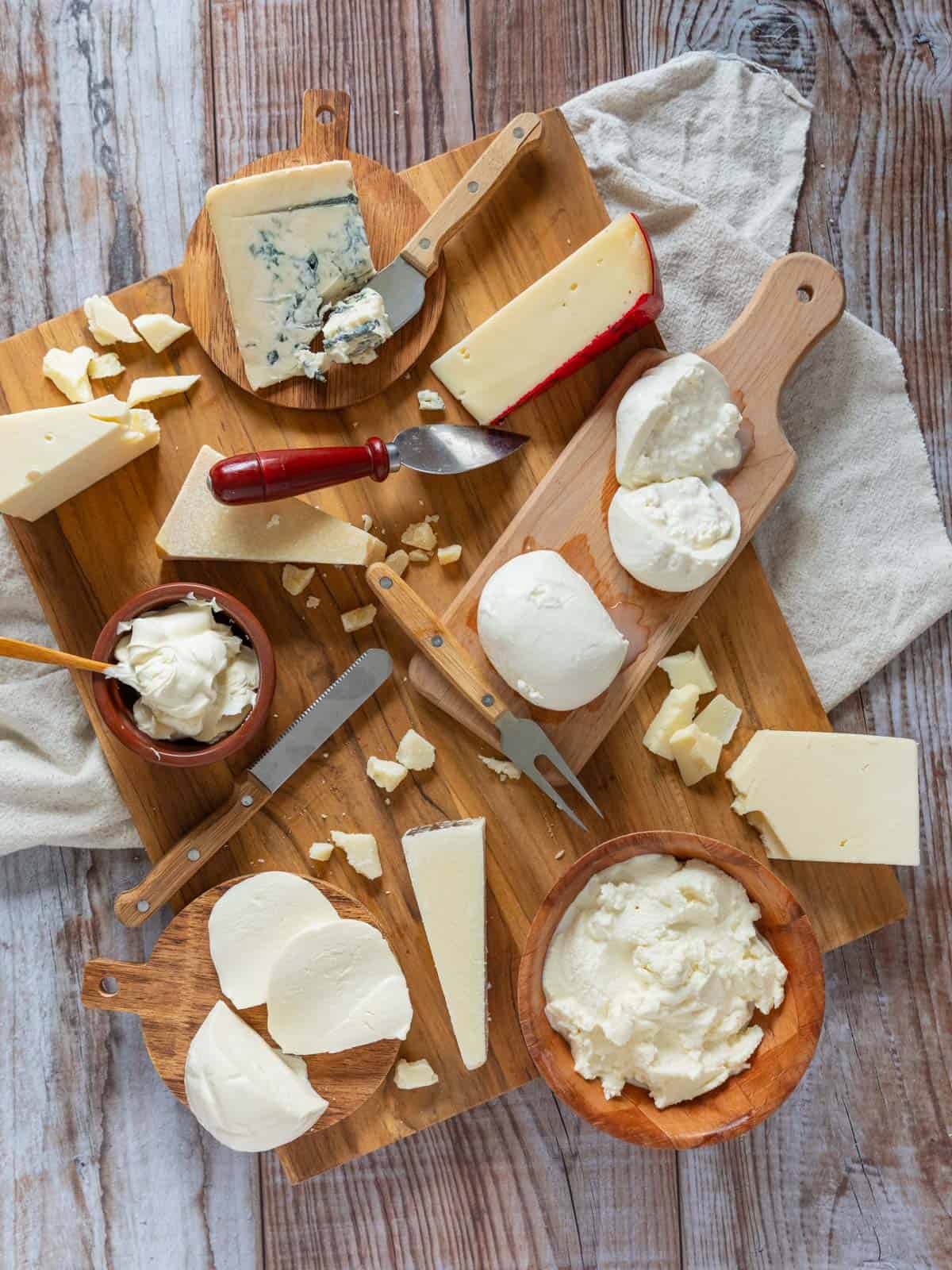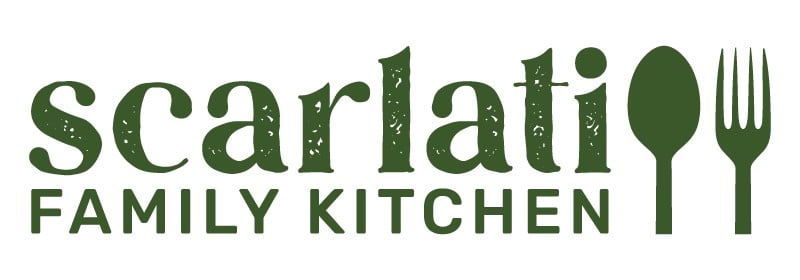Learn about the most popular and widely used Italian Cheeses in this guide. From melty mozzarella to pungent gorgonzola, I’ll break it all down for you here!

While France is famous for cheese, Italy certainly gives it a run for its money. And if we’re talking about the cheeses we use most in our day-to-day cooking, I think Italian cheeses win out.
But do you really know Italian cheese? In this guide to the best Italian cheeses, we’ll discuss some of the most iconic cheese offerings from Italy. We’ll cover their basic characteristics, where and how they’re made, and how to use them in your cooking.
First, let’s talk about what makes an Italian cheese authentic.
What Does DOP Mean for Italian Cheeses?
Not all cheese is created equal—and that’s why the DOP label was invented.
The DOP label, or Denominazione d' Origine Protetta (Protected Designation of Origin in English), is a certification that guarantees that the cheese, wine, or other Italian food you’re about to indulge in is the real deal—made in a specific region using traditional methods.
When it comes to Italian cheese, the DOP label is especially important. It ensures that the cheese you’re purchasing is truly authentic, locally made and packaged, and produced according to Italy's strict standards.
In short, DOP is a quick way of knowing you’re buying the best of the best.
Gorgonzola
Hailing from the Lombardi region of Italy, Gorgonzola is unique among Italian cheeses. Made from cow's milk, it’s known for its sharp, tangy flavor, which is often used to add some punch salads (like this Spinach Salad with Pairs) or pasta, or a bit of contrast when paired with fruit. A little goes a long way!

Gorgonzola is available in two types: dolce, which is soft, sweet, mild, and creamy, or piccante, which is aged over a year and boasts a more intense flavor with a harder, crumbly texture.
In the past, Gorgonzola would get its distinctive blue veins naturally from the penicillium found in the dark caves where it was aged. These days, the cheese is injected with an instigator mold to achieve that signature blue color.
Pecorino
Pecorino isn’t a single type of cheese, but instead a family of hard Italian cheeses made from sheep's milk. The six main varieties—Pecorino Romano, Sardo, Toscano, Siciliano, Di Filiano, and Crotonese—originate in different regions and each has its own unique characteristics and flavor profile.

What all Pecorino cheeses have in common is a tangy, nutty flavor that’s similar to Parmesan, but with a sharper and tangier edge. As these cheeses age, their flavor becomes more pronounced and the texture gets harder.
Among this family of Italian cheeses, Pecorino Romano is the most well-known and commonly used; it’s most famous for its starring role in the classic Italian pasta dish Cacio e Pepe.
Fontina
Originating in the Aosta Valley, Fontina is a versatile Italian cheese made from cow's milk. Depending on how long it’s been aged, Fontina can range from semi-soft to hard; it’s typically aged up to three months.

Compared to other hard or aged Italian cheeses, Fontina is an excellent melter, making it a great choice for panini and other hot sandwiches. That said, its mild, nutty flavor complements so many dishes, from Grilled Italian Steaks to soups, salads, and pizza. I especially love it in this Italian Breakfast Strata.
Mascarpone
Mascarpone is a rich, buttery, and creamy Italian cheese that originated in the Lombardy region. Made from cow's milk, it’s a double or triple cream cheese, which gives it a smooth, indulgent texture. The taste of mascarpone is similar to cream cheese, but more mellow and buttery than tangy.

Velvety mascarpone is a key ingredient in tiramisu (and my Tiramisu Cups!), but I also love the creaminess it adds to these Mini Lemon Cheesecakes and it makes the BEST Whipped Mascarpone Frosting. Don’t overlook it for savory dishes too, though. Mascarpone can add richness and depth to pasta or Creamy Shrimp Risotto.
Parmigiano-Reggiano
Parmigiano-Reggiano, hailed as the "King of Cheeses," is a cow’s milk cheese that originated in Emilia-Romagna. It’s now produced exclusively in the Italian provinces of Parma, Reggio Emilia, Modena, and Bologna to the east of the Reno River, and Mantua to the west of the Po River.

This most famous Italian cheese is renowned for its distinctive salty, nutty flavor and its popularity means it’s often imitated, but never duplicated! Parmigiano-Reggiano’s production is also highly regulated—by law, it can only be made from April through November, when cows can graze on fresh grass rather than hay.
Aged for about 2 years (but at least 1 year), Parmigiano-Reggiano undergoes a natural fermentation process within the first 48 hours of processing, rendering it naturally lactose-free. Cheeses that use different methods or are produced outside of the regions listed above may be called Parmesan, but legally, only Parmigiano-Reggiano earns the DOP label.
Parmigiano-Reggiano is a welcome addition to everything from pasta, soups, and salads to risotto and veggies. You’ll find it in my Creamy Polenta Recipe and Italian Celery Salad, among other recipes.
Mozzarella
Mozzarella is another iconic Italian cheese; this one has its origins in Naples. The most traditional and prized variety is Mozzarella di Bufala—and yes, it really is made from buffalo milk, which provides it with a distinct, rich flavor.
Regular mozzarella, on the other hand, is commonly produced from cow's milk. Varieties of mozzarella can differ based on their moisture content; high moisture mozzarella has a fresh and creamy flavor, but spoils faster, while lower moisture varieties have a longer storage life.

The process of producing mozzarella involves stretching the hot curds of cheese, a method known as Pasta Filata, which gives this Italian cheese its trademark elasticity. Most often, fresh mozzarella is sold in balls, which are sometimes smoked to add an extra layer of flavor. Unlike so many other Italian cheeses, which taste better with aging, mozzarella is actually best consumed as fresh as possible.
Mozzarella has a soft, buttery flavor and texture, with a high moisture content that allows it to melt beautifully when heated. The mild flavor and creaminess pair well with the bright flavors of tomatoes and basil; it’s also delicious atop crusty bread drizzled with olive oil and perfect for melting on a crispy-bottomed Cast Iron Pizza.
Ricotta
Ricotta cheese traces its origins back to the Italian countryside, where it was developed as a method to reduce waste. Essentially a cheese byproduct, Ricotta is made using the whey that's leftover from the production of other cheeses. The whey is cooked until the curds and whey separate, then the curds are cooked again to make Ricotta cheese. In fact, this process gives the cheese its name—“Ricotta" translates to "recooked" in Italian.

The result is a cheese with a creamy texture and a slight sweetness. Like mozzarella, Ricotta is not aged. Both its flavor and creaminess lend itself to a variety of dishes, from desserts like Lemon Ricotta Cake to Classic Lasagna with Ricotta Cheese.
Provolone
Provolone is an Italian cheese traditionally made in Basilicata, in Southern Italy. Like mozzarella, it’s produced using the pasta filata method, which involves stretching the cheese curds into the desired shape.

Made from cow's milk, Provolone can be aged anywhere from a few months to over a year, and it’s known for its buttery, nutty flavor. The aging process imparts a more intense, sharper taste to the cheese. Younger Provolone possesses a smooth, mild flavor, while the longer-aged versions develop a sharper, more robust taste.
Whether it's layered onto sandwiches with Italian cured meats, paired with vegetables, scrambled with eggs, or melted over hearty Italian Baked Meatballs, Provolone is a flavorful addition to so many dishes.
Asiago
Asiago cheese takes its name from its place of origin: the Asiago Plateau in the Po Valley of Northern Italy. Traditionally crafted from cow's milk, this cheese is highly versatile thanks to a variable aging process.

Fresh Asiago, known as Asiago Pressato, is aged just a few weeks, while Asiago d’Allevo is aged for several months, or up to a year. The younger version offers a creamy, smooth texture with a mild, sweet, slightly nutty flavor, while the more aged Asiago develops a harder, crumbly texture and a more robust nuttiness that's almost reminiscent of Parmesan.
Young Asiago's creaminess makes it a delicious addition to sandwiches or melted onto pizza, while aged Asiago can be grated over salads or served on a cheese or Charcuterie Board. It also adds a great flavor to this Baked Asiago Chicken.
Burrata
Burrata is a sumptuous Italian cheese from the town of Andria in Southern Italy. It’s also quite unique—the outside of Burrata is soft but solid mozzarella, while the inside is a rich combination of cheese curds and cream. Burrata is also a much younger cheese than the rest of the ones on our list—it was developed in the 20th century.

The production process for Burrata doesn't involve aging, so it's typically served fresh, just a few hours or days after it's made. (Of course, store-bought versions in the United States aren’t nearly as fresh!)
The rich, buttery taste of Burrata makes it a wonderful addition to pizza, but it’s also fantastic in a salad, spread onto crusty bread, or tossed with your favorite pasta. Or, simply serve it with fresh slices of tomato or peaches with basil and a drizzle of syrupy aged balsamic vinegar. Burrata’s luxurious texture and richness makes any dish feel just a little more indulgent.
Grana Padano
Grana Padano is another beloved Italian cheese that hails from the Po Valley in Northern Lombardy. This cheese is less complex than Parmigiano-Reggiano, but it still has a nutty, salty flavor—it just develops over a shorter aging period, which means it’s not as pungent.

The texture and flavor of Grana Padano varies depending on the length of its aging process. Grana Padano can be used as a substitute for Parmesan or Parmigiano-Reggiano in cooking; I love it in this Casarecce with Peas and Asparagus, where its nutty flavor complements the fresh spring vegetables.
More Cooking Resources
Hungry for more cooking knowledge? Learn more about How to Cook from Scratch in these posts:
How to Make Sauces from Scratch and How to Cook Pasta al Dente will make your pasta nights exceptional.
How to Season Food Properly—because what does it even mean to “season to taste”?
Kitchen Knife Safety Tips to help you use your knives like the pros.
If you ever don't recognize a tool or skill that is mentioned, be sure to look it up in our Glossary of Cooking Terms and Definitions for more information.






Allen
Fantastic summary. I use Pecorino Romano, Mozzarella, ricotta and Parmigiano-reggiano in my classic vegetarian Lasagna. It's a family favorite and vanishes
Amanda
Thank you Allen! That is the perfect combination of melty, sweet and salty. No wonder they love it!
JoeW
Nicely done, Amanda; a good summary.
Arguably, the best Italian cheese in the world is the bits of asiago that melt onto the baking surface under an asiago bagel. Kind of like the overflow from raclette toasts under the broiler. Completely changes the flavor.
Regards,
Joe
Amanda
Thanks Joe! I think I will have to agree with you on the asiago...it takes on a whole different flavor when it melts!
Chef Mimi
I agree. Italian cheeses are great for every day cooking, and in general I could never live without taleggio, fontina, and burrata. But there are too many stinky, especially washed rind cow’s milk French cheeses that must be in my life, and not necessarily for cooking. Epoisses, Reblochon, etc.
Amanda
Thanks Mimi! I agree, too many good cheeses to just keep to one list or one region!